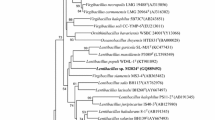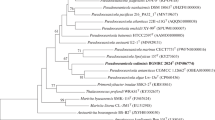Abstract
A novel Gram-positive, aerobic, motile, hemolytic, endospore-forming and rod-shaped bacterium TW25T was isolated from a dead ark clam during a mass mortality event on the South coast of Korea. The strain grew optimally at 30°C, at pH 8–9, and with 1% (w/v) NaCl. The 16S rRNA gene sequence analysis indicated that strain TW25T was associated with the genus Ornithinibacillus and that it was most closely related to the type strain of Ornithinibacillus californiensis (98.5% similarity). The dominant cellular fatty acids were iso-C15:0, anteiso-C15:0 and C16:0. The peptidoglycan amino acid type was A4β, containing l-ornithine and d-aspartic acid. The polar lipids were diphosphatidylglycerol, phosphatidylglycerol, four unidentified phospholipids, two unidentified aminolipids and two unidentified lipids. The major respiratory quinone was menaquinone-7 (MK-7). The G + C content of genomic DNA was 36.7 mol%. DNA–DNA hybridization experiments with related strains revealed lower than 11 ± 3% relatedness. Based on this polyphasic taxonomic study, strain TW25T represents a novel species in the genus Ornithinibacillus, for which the name Ornithinibacillus scapharcae sp. nov. is proposed. The type strain is TW25T (=KACC 15116T = JCM 17314T).

Similar content being viewed by others
References
Bae JW, Rhee SK, Park JR, Chung WH, Nam YD, Lee I, Kim H, Park YH (2005) Development and evaluation of genome-probing microarrays for monitoring lactic acid bacteria. Appl Environ Microbiol 71(12):8825–8835
Baker GC, Smith JJ, Cowan DA (2003) Review and re-analysis of domain-specific 16S primers. J Microbiol Methods 55(3):541–555
Bousfield GR, Sugino H, Ward DN (1985) Demonstration of a COOH-terminal extension on equine lutropin by means of a common acid-labile bond in equine lutropin and equine chorionic gonadotropin. J Biol Chem 260(17):9531–9533
Chang HW, Nam YD, Jung MY, Kim KH, Roh SW, Kim MS, Jeon CO, Yoon JH, Bae JW (2008) Statistical superiority of genome-probing microarrays as genomic DNA–DNA hybridization in revealing the bacterial phylogenetic relationship compared to conventional methods. J Microbiol Methods 75(3):523–530
Chun J, Lee JH, Jung Y, Kim M, Kim S, Kim BK, Lim YW (2007) EzTaxon: a web-based tool for the identification of prokaryotes based on 16S ribosomal RNA gene sequences. Int J Syst Evol Microbiol 57(Pt 10):2259–2261
Collins MD, Jones D (1981a) Distribution of isoprenoid quinone structural types in bacteria and their taxonomic implication. Microbiol Rev 45(2):316–354
Collins MD, Jones D (1981b) A note on the separation of natural mixtures of bacterial ubiquinones using reverse-phase partition thin-layer chromatography and high performance liquid chromatography. J Appl Bacteriol 51(1):129–134
Ezaki T, Hashimoto Y, Yabuuchi E (1989) Fluorometric deoxyribonucleic acid-deoxyribonucleic acid hybridization in microdilution wells as an alternative to membrane filter hybridization in which radioisotopes are used to determine genetic relatedness among bacterial strains. Int J Syst Evol Microbiol 39(3):224–229
Felsenstein J (1981) Evolutionary trees from DNA sequences: a maximum likelihood approach. J Mol Evol 17(6):368–376
Hall TA (1999) BIOEDIT: a user-friendly biological sequence alignment editor and analysis program for Windows 95/98/NT. Nucleic Acids Symp Ser 41:95–98
Kafatos FC, Jones CW, Efstratiadis A (1979) Determination of nucleic acid sequence homologies and relative concentrations by a dot hybridization procedure. Nucleic Acids Res 7(6):1541–1552
Kämpfer P, Falsen E, Lodders N, Langer S, Busse HJ, Schumann P (2010) Ornithinibacillus contaminans sp. nov., an endospore-forming species. Int J Syst Evol Microbiol 60(Pt 12):2930–2934
Kluge AG, Farris FS (1969) Quantitative phyletics and the evolution of anurans. Syst Zool 18:1–32
Logan NA, Berge O, Bishop AH, Busse HJ, De Vos P, Fritze D, Heyndrickx M, Kampfer P, Rabinovitch L, Salkinoja-Salonen MS, Seldin L, Ventosa A (2009) Proposed minimal standards for describing new taxa of aerobic, endospore-forming bacteria. Int J Syst Evol Microbiol 59(Pt 8):2114–2121
Loy A, Schulz C, Lucker S, Schopfer-Wendels A, Stoecker K, Baranyi C, Lehner A, Wagner M (2005) 16S rRNA gene-based oligonucleotide microarray for environmental monitoring of the betaproteobacterial order “Rhodocyclales”. Appl Environ Microbiol 71(3):1373–1386
Mayr R, Busse HJ, Worliczek HL, Ehling-Schulz M, Scherer S (2006) Ornithinibacillus gen. nov., with the species Ornithinibacillus bavariensis sp. nov. and Ornithinibacillus californiensis sp. nov. Int J Syst Evol Microbiol 56(Pt 6):1383–1389
Rochelle PA, Fry JC, Parkes RJ, Weightman AJ (1992) DNA extraction for 16S rRNA gene analysis to determine genetic diversity in deep sediment communities. FEMS Microbiol Lett 79(1–3):59–65
Saitou N, Nei M (1987) The neighbor-joining method: a new method for reconstructing phylogenetic trees. Mol Biol Evol 4(4):406–425
Schaeffer AB, Fulton MD (1933) A Simplified Method of Staining Endospores. Science 77(1990):194
Tamura K, Peterson D, Peterson N, Stecher G, Nei M, Kumar S (2011) MEGA5: molecular evolutionary genetics analysis using maximum likelihood, evolutionary distance, and maximum parsimony methods. Mol Biol Evol. doi:10.1093/molbev/msr121
Thompson JD, Higgins DG, Gibson TJ (1994) CLUSTAL W: improving the sensitivity of progressive multiple sequence alignment through sequence weighting, position-specific gap penalties and weight matrix choice. Nucleic Acids Res 22(22):4673–4680
Tindall BJ (1990) Lipid composition of Halobacterium lacusprofundi. FEMS Microbiol Lett 66:199–202
Tittsler RP, Sandholzer LA (1936) The use of semi-solid agar for the detection of bacterial motility. J Bacteriol 31(6):575–580
Wayne LG, Brenner DJ, Colwell RR (1987) Report of the ad hoc committee on reconciliation of approaches to bacterial systematics. Int J Syst Bacteriol 37:463–464
Whon TW, Roh SW, Shin NR, Kim MS, Kim YO, Bae JW (2011) Genome sequence of strain TW25, a novel member of the genus Ornithinibacillus in the family Bacillaceae. J Bacteriol 193(11):2884–2885
Xin H, Itoh T, Zhou P, Suzuki K, Kamekura M, Nakase T (2000) Natrinema versiforme sp. nov., an extremely halophilic archaeon from Aibi salt lake, Xinjiang, China. Int J Syst Evol Microbiol 50:1297–1303
Acknowledgments
We thank Dr. J. P. Euzéby (École Nationale Vétérinaire, France) for etymological advice. This work was supported by 21C Frontier Microbial Genomics and Application Center Program, and the grant from the National Fisheries Research and Development Institute (NFRDI), Republic of Korea. The GenBank/EMBL/DDBJ accession number for the 16S rRNA gene sequence of strain TW25T is HQ171440.
Author information
Authors and Affiliations
Corresponding author
Additional information
Na-Ri Shin and Tae Woong Whon contributed equally to this work.
Electronic supplementary material
Below is the link to the electronic supplementary material.
10482_2011_9645_MOESM1_ESM.ppt
Supplementary Fig. S1. Phase contrast micrograph of strain TW25T after growth on TSA for 24 h, showing the endospore with swollen sporangia (A), and transmission electron micrograph of a cell of strain TW25T (B). Arrow indicates the peritrichous flagella of strain TW25T. (PPT 2995 kb)
10482_2011_9645_MOESM2_ESM.ppt
Supplementary Fig. S2. Two-dimensional thin-layer chromatograms of polar lipids from strain TW25T. Total lipids were revealed using Ornithinibacillus bavariensis WSBC 24001T. Abbreviations: DPG, diphosphatidylglycerol; PG, phosphatidylglycerol; PL1-4, unidentified phospholipids; AL1-2, unidentified aminolipids; L1-2, unidentified lipids. (PPT 239 kb)
Rights and permissions
About this article
Cite this article
Shin, NR., Whon, T.W., Kim, MS. et al. Ornithinibacillus scapharcae sp. nov., isolated from a dead ark clam. Antonie van Leeuwenhoek 101, 147–154 (2012). https://doi.org/10.1007/s10482-011-9645-3
Received:
Accepted:
Published:
Issue Date:
DOI: https://doi.org/10.1007/s10482-011-9645-3




